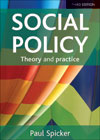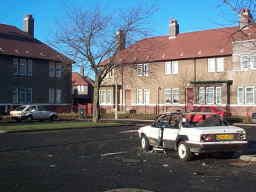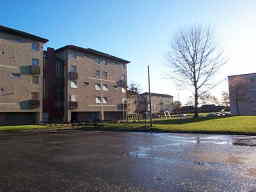
Tents used by homeless people in Los Angeles.
An introduction to Social Policy

Housing policy is usually analysed in economic terms, as a form of market. In theory, markets lead to efficient allocation through a complex process of matching supply and demand. This depends on competition (to bring prices down); good information; the existence of multiple suppliers; and the existence of multiple purchasers. In housing, this theory has limited application. Barlow and Duncan point to
View an image from the University of Kent Centre for
the
Study of Cartoon and Caricature:
Problem
of the homeless
(Cartoon by David Low, 1940)
The root of many problems in Europe is a shortage of adequate housing. This statement may seem strange, because most European countries have a crude surplus of houses over households. There are three main reservations to make about that calculation.
Good housing is in short supply. That makes it expensive. Because
housing operates in a market, the people who are most likely to be left
out will be those who have least resources. People have to live where
they can; so they have to live in unfit accommodation, and they may
have to accept overcrowding. Eurostat estimates that 17% of the European
population, about one in six, is overcrowded. The shortage also
leads to increasing
prices, creating problems in the supply of affordable housing.

Tents used by homeless people in Los Angeles.
Homelessness is a complex problem; the circumstances of homeless people vary greatly. At root, though, the reasons for homelessness come down to four main issues:
Many of the key issues in deprivation are housing issues. The Breadline Britain surveys, identifying what people thought of as 'essential', came up with answers like a damp free home, heating, indoor toilet, the use of a bath, home decoration, having enough beds and refrigeration - the last two depending on space. [3]

An unpopular estate, with burnt
out car.
Photograph: Paul Spicker
Deprivation is often concentrated. Slum estates occur in both the private and the public sectors. In the private sector, poor people are brought together through the market; those least able to exercise choice end up in the places least to be chosen. The same is true, to some extent, of the public sector. Where applicants for social housing are allowed a choice, the people most able to exercise that choice are those who have the highest incomes and the best housing previously. They are the ones who can wait for a better offer. Social segregation by housing officers has contributed to this process in the past, but it equally happens in the private sector where this has not happened.
However, deprivation is not only concentrated. Concentration means only that there are higher proportions of poorer people in poorer areas, not that everyone is poor. Most poor people do not live in poor areas, and most of the people who live in these areas are not poor.External link: Paul
Spicker: Poor areas and the ecological fallacy
The term "urban policy" is used for a wide range of different concerns and activities, not all of it urban. The key issues relate to
This does not define a very distinct area of concern, and some issues, like local economic policy, are not certainly "urban" at all.
Urban policy has mainly been distinguished by attempts to treat economic and social issues in localised settings. The characteristic modes of work include
Housing in Britain is commonly classified according to tenure. The main tenures are owner-occupation, local authority housing, registered social landlords (including housing associations and stock transfers), and private rented housing.
Since the beginning of the 20th century, there has been a major change in tenure. Owner occupation grew from 10% to 67% of the stock, but recently it has fallen back to 63%; private renting declined from 90% to less than 10%, and has grown to 18%; and a large social housing sector, mainly represented by council housing, grew to about a third before its reduction to less than 18%. People on low incomes tend now to be concentrated in social rented housing; the average income of council and housing association tenants is just over a quarter of the income of people who are buying houses with a mortgage.
The growth of owner-occupation in Britain is built on a solid legal foundation, stable finance and a history of tax advantages, particularly from the 1960s to the 1990s. The Building Societies were central to this growth. They were founded on a social, co-operative and non-profit making basis, but in the 1990s many became banks, abandoning the mutualist tradition.
Owner-occupiers tend to fall into two main groups. Those who own their house outright are mainly older people, often on fairly low incomes, who have paid off their mortgage. Those who are on higher incomes will generally invest in housing by taking out further mortgages. Whether one is in the process of buying a house or not is strongly related to income.
Policies to encourage ownership have necessarily been directed at people on lower incomes, because those on higher incomes were already buying. This expansion has led to other problems, including
Private rented housing declined proportionately after 1919, because the growth of owner-occupation and local authority housing took out a large part of the market. Since the 1920s, it has been cheaper to buy than to rent, and capital values have been dictated by sale to owner-occupiers. As the stock aged, it bore the brunt of clearance. The sector declined numerically from 1945 to the late 1980s. The decline of the sector was marked by poor standards and abuse by landlords. Deregulation in 1957, intended to revitalise the sector, had the reverse effect; it facilitated the exit of landlords from the market. The Rent Acts of the 1960s were designed to protect tenants from abuse and to give them some security. The law was widely disregarded by landlords and by the courts; in so far as regulation did have an effect, it was probably to slow down the rate of decline by preventing landlords from selling. In 1988, there was further deregulation, with the creation of the shorthold tenancy to allow landlords to obtain vacant posession and resell. It had limited direct effect on supply (the sector has expanded, but most of that expansion happened more than twenty years later).
The sector covers several distinct markets, such as student accommodation, delayed sales (where owners hope to have some income until they can sell at a favourable rate), and the government's subsidy of rents through Housing Benefit. There also tends to be more private renting in certain areas, when there is a special market for short term lettings, such as holiday lets, or a student population. However, there has been a substantial increase in supply. The principal economic determinants of supply have been not deregulation, but
'Buy to let' is favoured only if the rate of return (capital accumulation plus rental income, minus expenses) is better than other investments. The combination of factors has led to a marked expansion of the sector since 2007, increasing the size of the sector by 50%.

Local authorities provided decent housing for millions of
people. Many of the properties in this photo have been sold.
Photograph: Paul Spicker
Local authority housing grew after World War I. 1.3 million houses
were built before 1939 (1.1 m in England and Wales, over 0.2 million in
Scotland). There were over 4.3 million by 1961, and 6.1 million
by 1981. Initially,
council housing was intended for the "working classes". The main
justification for its development after 1919 was the provision of
housing for general needs, but after 1930, it became focused on people
displaced after slum clearance. The stigma of council housing probably
dates from this period: council estates were built in locations where
they would not adversely affect the values of owner-occupied property,
and some were walled off to avoid private residents having to make
contact with council tenants.[4]
After World War II, references to the 'working classes' were removed. The replacement of the housing stock, particularly through clearances, became council housing's main role, with mass building. The subsidies favoured industrial, high-rise building, though this was often more expensive than the alternatives. Quantity was more important than quality. [5]
Housing policy changed after 1970, when political support for council housing was withdrawn by the Conservatives; changes in finance, less housebuilding and some sales slowed the growth of the sector to 1981. The numbers of council houses started to fall. In the 1970s and 80s, council housing acquired a more residual role, and is now more concerned with welfare issues and special needs. General subsidies have been progressively withdrawn; for most tenants they have been replaced by Housing Benefit. The sale of council housing to tenants at a discount reduced the numbers, but in due course the government found that few remaining tenants could afford to buy on any terms. The policy of reducing the role of council housing subsequently focused on mass transfers of stock to Registered Social Landlords. [6] As the role of council housing has diminished, Housing Associations have been encouraged to take over the limited opportunities for development.
External link: Early social housing | The development of housing in Birmingham, 1906-65 | The history of council housing

An unpopular estate, emptied in
preparation for demolition.
Photograph: Paul Spicker
The 'worst estates' have become a central focus of policies dealing with 'social exclusion'. Their problems are the problems of poverty. People who are poor live differently: they are stuck at home more, they cannot afford enough heat to avoid damp. Rich people without young children would not necessarily have the same problems. Examples of problems in poor areas are:
Housing conditions in many cities are particularly unsatisfactory; the houses are old and in poor condition. A series of policies since the late 1960s have focused on the problems of deprivation in inner city areas. Much of the concern with the inner cities grew from an attempt to produce an acceptable racial policy. Despite this, Rex states that ethnic minorities did not get even a proportionate share of resources from policies for the inner cities. [7]
The basic criticisms of inner city policy are:
Further reading
Housing and homelessness, from the British Library Social Welfare Portal